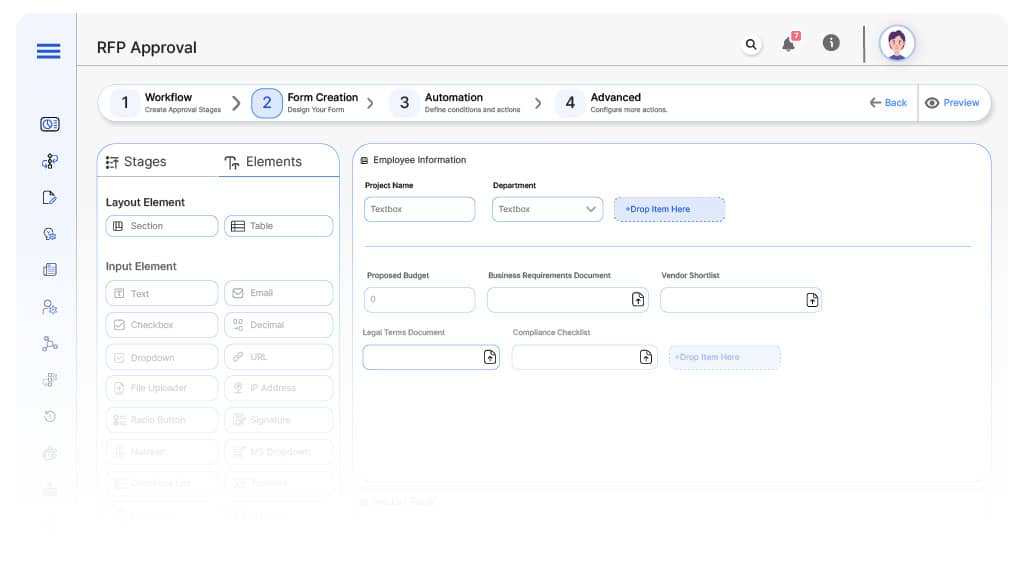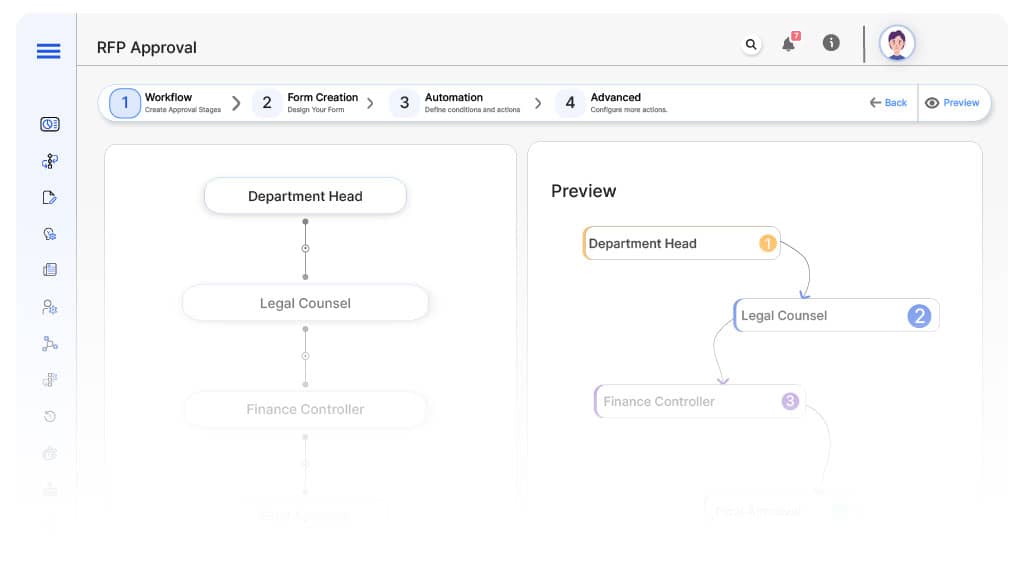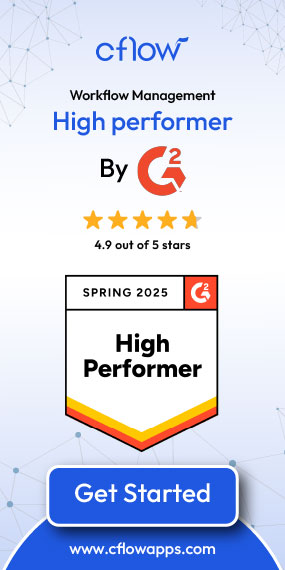- Cflow
- RFP Approval Automation
RFP Approval Automation: Explained - Cflow

Clow Team

The RFP (Request for Proposal) process is a crucial part of vendor selection and procurement planning. Without automation, manual RFP approvals lead to delays, compliance risks, poor supplier alignment, and missed cost-saving opportunities. Recent industry research shows that 63% of organizations experience delays in procurement due to inefficient RFP review processes.
Without automation, procurement officers, department heads, legal teams, finance controllers, and leadership struggle to validate RFP scopes, approve vendor criteria, ensure compliance, and track approval timelines. This guide walks you through exactly how Cflow automates RFP Approval Process, from RFP drafting to final release to suppliers.
What Is RFP Approval Process?
The RFP Approval Process governs how RFP documents are created, reviewed, and authorized before they are shared with potential suppliers, ensuring alignment with business goals, legal compliance, and financial policies.
Think of RFP approvals like strategic blueprints , every RFP requires scope validation, stakeholder alignment, financial vetting, legal review, and executive approval before supplier release.
Recent industry research shows that automating RFP approvals reduces procurement cycle time by 50% and improves vendor engagement outcomes by 65%.
Why RFP Approval Matters for Organizations
Strategic Alignment
Legal Compliance
Cost Control
Audit Trail
Try Cflow for free, no credit card needed
Key Benefits of Automating RFP Approval with Cflow
- Centralized RFP Submission Portal : Cflow allows procurement teams to submit RFP drafts with scope documents, vendor lists, budget information, and legal terms into a single workflow.
- Dynamic Routing Based on RFP Value : Cflow applies routing logic based on project size, strategic impact, vendor type, and legal exposure.
- Multi-Level Approval Workflows : Requests route through department heads, legal, procurement directors, finance controllers, CFOs, and executives depending on project complexity.
- Real-Time Notifications & Escalations : Automated alerts ensure timely RFP reviews while escalation rules prevent supplier delays.
- Policy Compliance Validation : Cflow enforces checks against procurement guidelines, legal policies, and vendor selection criteria before RFP release.
- Full Audit Trail & Approval Logs : Every RFP draft, revision, approval, and final release is archived for future audits.
- Mobile Accessibility : Stakeholders can review, comment, and approve RFPs from any location, ensuring speed and flexibility.
Get the best value for money with Cflow
User Roles & Permissions
Procurement Specialist (Initiator)
- Responsibilities: Submit RFP drafts with business requirements, vendor lists, and initial budget estimates.
- Cflow Permission Level: Submit Form.
- Mapping: “Procurement Team.”
Department Head
- Responsibilities: Validate business need, project scope, and internal resource alignment.
- Cflow Permission Level: Approve/Reject.
- Mapping: “Department Group.”
Legal Counsel
- Responsibilities: Review legal clauses, compliance obligations, and vendor risk exposure.
- Cflow Permission Level: Approve/Reject.
- Mapping: “Legal Group.”
Finance Controller
- Responsibilities: Validate budget codes, financial limits, and cash flow availability.
- Cflow Permission Level: Approve/Reject.
- Mapping: “Finance Team.”
CFO (Conditional)
- Responsibilities: Final sign-off for high-value or sensitive RFPs.
- Cflow Permission Level: Approve/Reject.
- Mapping: “CFO Group.”
Executive Leadership (Conditional)
- Responsibilities: Final approval for strategic or cross-functional RFPs.
- Cflow Permission Level: Approve/Reject.
- Mapping: “Executive Board.”
Discover why teams choose Cflow
Form Design & Field Definitions

Field Label: RFP Request ID
- Type: Autonumber
- Auto-Populate: Generated on submission.
Field Label: Project Name
- Type: Text
- Logic/Rules: Mandatory.
Field Label: Department
- Type: Dropdown
- Logic/Rules: Mandatory.
Field Label: Proposed Budget
- Type: Numeric Field
- Logic/Rules: Drives routing.
Field Label: Business Requirements Document
- Type: File Upload
- Logic/Rules: Mandatory.
Field Label: Vendor Shortlist
- Type: File Upload
- Logic/Rules: Optional.
Field Label: Legal Terms Document
- Type: File Upload
- Logic/Rules: Mandatory.
Field Label: Compliance Checklist
- Type: File Upload
- Logic/Rules: Mandatory.
Field Label: Legal Review Notes
- Type: Text Area
- Logic/Rules: Required for legal counsel.
Field Label: Finance Review Notes
- Type: File Upload
- Logic/Rules: Mandatory for compliance officer.
Field Label: CFO Comments
- Type: Text Area
- Logic/Rules: Required for finance controller.
Field Label: Executive Comments
- Type: Text Area
- Logic/Rules: Required for legal counsel.
Field Label: RFP Release Confirmation
- Type: Checkbox
- Logic/Rules: Procurement marks RFP as finalized and released.
Transform your Workflow with AI fusion
Approval Flow & Routing Logic

Submission → Department Head
- Status Name: Pending Department Review
- Notification Template: “Hi Department Head, new RFP draft submitted for scope validation.”
- On Approve: Moves to Legal Counsel.
- On Reject: Returns to Procurement Specialist.
- Escalation: Reminder after 1 day.
Department → Legal Counsel
- Status Name: Pending Legal Review
- Notification Template: “Hi Legal, RFP draft requires legal validation.”
- On Approve: Moves to Finance Controller.
- On Reject: Returns to Department Head.
- Escalation: Reminder after 1 day.
Legal → Finance Controller
- Status Name: Pending Finance Review
- Notification Template: “Hi Finance, RFP draft requires financial review.”
- On Approve: Moves to CFO (if applicable).
- On Reject: Returns to Legal Counsel.
- Escalation: Reminder after 1 day.
Finance → CFO (Conditional)
- Status Name: Pending CFO Approval
- Notification Template: “Hi CFO, high-value RFP requires final financial sign-off.”
- On Approve: Moves to Executive Leadership (if applicable).
- On Reject: Returns to Finance Controller.
- Escalation: Reminder after 1 day.
CFO → Executive Leadership (Conditional)
- Status Name: Pending Executive Approval
- Notification Template: “Hi Board, strategic RFP draft requires final leadership sign-off.”
- On Approve: Moves to RFP Authorized.
- On Reject: Returns to CFO.
- Escalation: Reminder after 1 day.
Final → RFP Authorized
- Status Name: RFP Approved & Released
- Notification Template: “RFP fully approved and released to supplier pool.”
Transform your AI-powered approvals
Implementation Steps in Cflow
Create a new workflow
Design the form
Set up User Roles/Groups
Build the process flow diagram
Configure notifications
Set conditional logic
Save and publish workflow
Activate process.
Test with a sample request
Adjust logic if needed
Go live
Example Journey: IT Services RFP
Procurement Specialist submits $600,000 IT outsourcing RFP. Cflow assigns ID RFP-2025-130. Department Head validates scope, Legal reviews compliance clauses, Finance validates budget, CFO signs off, Executive Board approves due to strategic nature. RFP released to vendors.
FAQ's
Setup typically completes within 5–7 business days.
Unleash the full potential of your AI-powered Workflow

